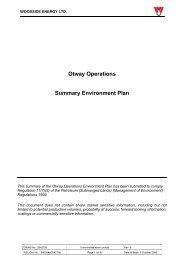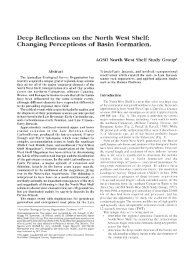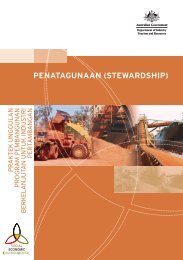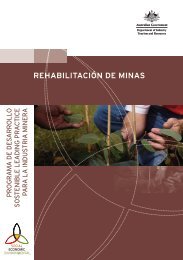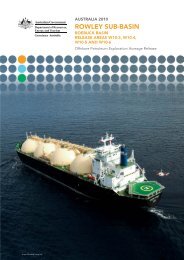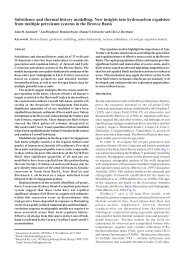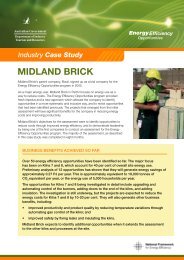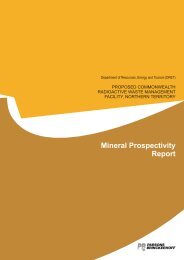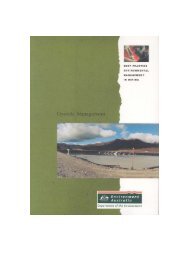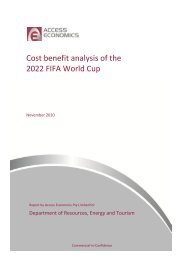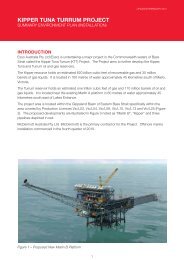A guide to leading practice sustainable development in mining
A guide to leading practice sustainable development in mining
A guide to leading practice sustainable development in mining
You also want an ePaper? Increase the reach of your titles
YUMPU automatically turns print PDFs into web optimized ePapers that Google loves.
Responsible management of biodiversity, <strong>in</strong> conjunction with key stakeholder groups<br />
such as regula<strong>to</strong>rs and <strong>in</strong>digenous peoples, is a key element of <strong>lead<strong>in</strong>g</strong> <strong>practice</strong><br />
<strong>susta<strong>in</strong>able</strong> <strong>development</strong> <strong>in</strong> the m<strong>in</strong><strong>in</strong>g <strong>in</strong>dustry. Engagement with these groups is<br />
discussed further <strong>in</strong> the Lead<strong>in</strong>g Practice Handbooks on Community Engagement and<br />
Development and Work<strong>in</strong>g with Indigenous Communities.<br />
An example of this <strong>lead<strong>in</strong>g</strong> <strong>practice</strong> approach <strong>in</strong> community partnerships is at<br />
Tiwest’s Cooljarloo heavy m<strong>in</strong>eral m<strong>in</strong>e site <strong>in</strong> WA (see LP Biodiversity p.6). Tiwest’s<br />
philosophy of add<strong>in</strong>g value <strong>in</strong> partnership is apparent <strong>in</strong> biodiversity partnerships<br />
with the Perth Zoo, Department of Environment and Conservation and local schools.<br />
Jo<strong>in</strong>t work with the Department of Conservation and Land Management’s (CALM)<br />
Western Shield program has seen regional fox numbers reduced <strong>to</strong> the po<strong>in</strong>t where<br />
there have been successful releases of woylies, Tammar Wallabies and Quenda <strong>in</strong><strong>to</strong><br />
nearby Nambung National Park. The Cooljarloo operation is based on an approach<br />
<strong>to</strong> <strong>susta<strong>in</strong>able</strong> <strong>development</strong> that <strong>in</strong>corporates a broad range of <strong>lead<strong>in</strong>g</strong> <strong>practice</strong><br />
approaches, <strong>in</strong>clud<strong>in</strong>g:<br />
the collection of seed from mature plants before disturbance.<br />
materials segregation (<strong>to</strong>psoil, clay overburden, processed material) that<br />
contributes <strong>to</strong> the rehabilitation and the establishment of landforms,<br />
particularly the management of f<strong>in</strong>e clay slurries or ‘slimes’.<br />
support<strong>in</strong>g the re-colonisation of locally ext<strong>in</strong>ct faunal<br />
species with<strong>in</strong> nearby national parks.<br />
partnerships with local <strong>in</strong>digenous bus<strong>in</strong>ess enterprises for seed collection<br />
and other services. For example, Tiwest’s partnership with Bill<strong>in</strong>ue Aborig<strong>in</strong>al<br />
Community is now <strong>in</strong> its 12th year with over a million dollars worth of local<br />
provenance seed collected and 700 ha of disturbed land revegetated.<br />
ongo<strong>in</strong>g partnerships with a wide cross-section of the local<br />
community cover<strong>in</strong>g educational projects, environmental<br />
management and support for community organisations.<br />
Manag<strong>in</strong>g impacts on terrestrial vegetation and fauna<br />
The first step <strong>to</strong> m<strong>in</strong>imis<strong>in</strong>g direct impacts on vegetation and associated faunal<br />
communities is <strong>to</strong> identify the location of values from survey <strong>in</strong>formation. From this<br />
environmental management plans can be developed and implemented <strong>to</strong> ensure that,<br />
where possible, high value areas are not cleared. In all <strong>in</strong>stances, these plans should<br />
ensure that the extent of clear<strong>in</strong>g is m<strong>in</strong>imised, consistent with the safe and efficient<br />
operation of the m<strong>in</strong>e. The extent of suitable habitat and its connectivity should allow<br />
for the mobility of most fauna species. Successional aspects are also important. For<br />
example, <strong>in</strong>appropriate fire regimes can affect all of a remnant area with<strong>in</strong> a m<strong>in</strong><strong>in</strong>g<br />
lease result<strong>in</strong>g <strong>in</strong> the loss of certa<strong>in</strong> species. Rapid rehabilitation of disturbed areas<br />
can m<strong>in</strong>imise the impacts of habitat fragmentation.<br />
Even <strong>in</strong> <strong>in</strong>stances where rare or threatened fauna species are no longer present <strong>in</strong><br />
an area, if surveys show the habitat <strong>to</strong> be either formerly occupied by the species, or<br />
suitable, then it should be managed accord<strong>in</strong>gly, s<strong>in</strong>ce it is possible that the species<br />
may colonise (when threaten<strong>in</strong>g process such as fox predation are removed or<br />
reduced), or be re<strong>in</strong>troduced at some later stage.<br />
92 LEADING PRACTICE SUSTAINABLE DEVELOPMENT PROGRAM FOR THE MINING INDUSTRY






